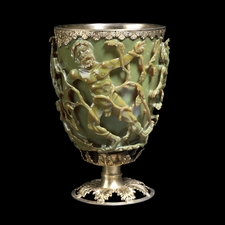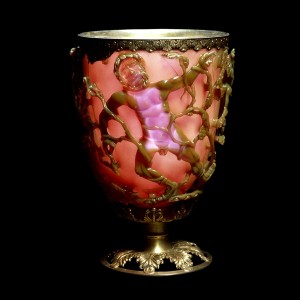The Lycurgus Cup is one of the great artistic achievements in history and there’s a nanotechnology twist to this art work created in the 4th century CE (or AD). From the Nov. 21, 2013 news item on Nanowerk,
A 1700-year-old Roman glass cup is inspiring University of Adelaide [Australia] researchers in their search for new ways to exploit nanoparticles and their interactions with light.
Researchers in the University’s Institute for Photonics and Advanced Sensing (IPAS) are investigating how to best embed nanoparticles in glass – instilling the glass with the properties of the nanoparticles it contains.
Before going further with this latest work at the University of Adelaide, here’s an excerpt from my Sept. 21, 2010 posting where I burbled on about the best of piece of writing I’ve seen about the Lycurgus Cup (held in the British Museum),
The *History of the Ancient World website (as Nov. 21, 2013 the link has been changed to the Université de Strasbourg,, Matière Condensée et Nanophysique website) recently featured a 2007 article about the Lycurgus Cup by Ian Freestone, Nigel Meeks, Margaret Sax and Catherine Higgitt for the Gold Bulletin, Vol. 40:4 (2007),
The Lycurgus Cup represents one of the outstanding achievements of the ancient glass industry. This late Roman cut glass vessel is extraordinary in several respects, firstly in the method of fabrication and the exceptional workmanship involved and secondly in terms of the unusual optical effects displayed by the glass.
The Lycurgus Cup is one of a class of Roman vessels known as cage cups or diatreta, where the decoration is in openwork which stands proud from the body of the vessel, to which it is linked by shanks or bridges Typically these openwork “cages” comprise a lattice of linked circles, but a small number have figurative designs, although none of these is as elaborate or as well preserved as the Lycurgus Cup. Cage cups are generally dated to the fourth century A.D. and have been found across the Roman Empire, but the number recovered is small, and probably only in the region of 50-100 examples are known. They are among the most technically sophisticated glass objects produced before the modern era.
Here’s what it looks like,

The Lycurgus Cup 1958,1202.1 in reflected light. Scene showing Lycurgus being enmeshed by Ambrosia, now transformed into a vine-shoot. Department of Prehistory and Europe, The British Museum. Height: 16.5 cm (with modern metal mounts), diameter: 13.2 cm. © The Trustees of the British Museum
And this, too, is the one and only Lycurgus Cup,

The Lycurgus Cup 1958,1202.1 in transmitted light. Scene showing Lycurgus being enmeshed by Ambrosia, now transformed into a vine-shoot. Department of Prehistory and Europe, The British Museum. Height: 16.5 cm (with modern metal mounts), diameter: 13.2 cm. © The Trustees of the British Museum
The Nov. 21, 2013 University of Adelaide, news release, which originated the news item, explains why the Lycurgus Cup is of such interest, and why the same cup can be green or red
The Lycurgus Cup, a 4th century cup held by the British Museum in London, is made of glass which changes colour from red to green depending on whether light is shining through the Cup or reflected off it. It gets this property from gold and silver nanoparticles embedded in the glass.
“The Lycurgus Cup is a beautiful artefact which, by accident, makes use of the exciting properties of nanoparticles for decorative effect,” says Associate Professor Ebendorff-Heidepriem. “We want to use the same principles to be able to use nanoparticles for all sorts of exciting advanced technologies.”
Nanoparticles need to be held in some kind of solution. “Glass is a frozen liquid,” says Associate Professor Ebendorff-Heidepriem. “By embedding the nanoparticles in the glass, they are fixed in a matrix which we can exploit.”
Associate Professor Ebendorff-Heidepriem is leading a three-year Australian Research Council Discovery Project to investigate how best to embed nanoparticles; looking at the solubility of different types of nanoparticles in glass and how this changes with temperature and glass type, and how the nanoparticles are controlled and modified.
Practical applications, according to the news release, include,
“Nanoparticles and nanocrystals are the focus of research around the world because of their unique properties that have the potential to bring great advances in a wide range of medical, optical and electronic fields,” says Associate Professor Heike Ebendorff-Heidepriem, Senior Research Fellow in the University’s School of Chemistry and Physics. “A process for successfully incorporating nanoparticles into glass, will open the way for applications like ultra low-energy light sources, more efficient solar cells or advanced sensors that can see inside the living human brain.”
“We will be able to more readily harness these nanoscale properties in practical devices. This gives us a tangible material with nanoparticle properties that we can shape into useful forms for real-world applications. And the unique properties are actually enhanced by embedding in glass.”